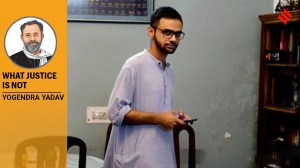Drop in pre-school enrollment rate| Pandemic reversed steady gains among Gujarat school kids: ASER
ASER is back after a gap of four years and comes at a time when children are back in schools after an extended period of closure owing to the pandemic.
 The Covid-19 pandemic interrupted the steady improvement the state witnessed between 2014 and 2018 in reading and math, the study finds. (Express Photo by Prashant Khanna)
The Covid-19 pandemic interrupted the steady improvement the state witnessed between 2014 and 2018 in reading and math, the study finds. (Express Photo by Prashant Khanna) The enrollment rate of kids in Anganwadis saw a sharp decline as compared to pre-Covid figures of 2018 while there has been a rise in the proportion of children in the 3-4 years age group who are yet to be enrolled in pre-primary schools in Gujarat, according to the findings of the Annual Status of Education Report (ASER) 2022 for Rural India released by Pratham Foundation, Wednesday.
The Covid-19 pandemic interrupted the steady improvement the state witnessed between 2014 and 2018 in reading and math, the study finds.
The state also witnessed the lowest proportion of Class 5 students across India who could read simple sentences in English. The study reveals that Gujarat has fared poorly in most areas compared to the rest of India between 2018 and 2022.
While the enrollment rate among the 3-year-olds dropped from 4.9 per cent to 17.2 per cent, that of the 4-year-olds declined from 2.5 per cent to 8.1 per cent during the same period. The numbers are a departure from the national average of 78.3 per cent in 2022—an increase of 7.1 percentage points over 2018—across rural India.
Among Class 5 students of the state, only 8.2 per cent—the lowest in India could read simple sentences in English. Of these, only 67.5 per cent could tell their meaning. “Despite English being taught as a subject from Class 3, it is very basic and without textbooks. It is from Class 5 when a child is actually exposed to the subject,” said Renu Seth, Pratham programme officer in Gujarat.
The study states that in 2022, less than one in four children were at grade-level in reading and math. “This means that most children urgently need help in acquiring foundational skills in literacy and numeracy. Big changes in practice and appropriate activities and high efforts are needed in the classroom if all children are to achieve basic foundational literacy and numeracy by Class III by 2027,” the state report highlights.
In the past 10 years, the proportion of Class 5 and 8 students who could read Class 2-level text dropped sharply. While nearly 81 per cent of the surveyed Class 8 students in 2012 could read a Class 2-level text, the proportion dropped to 73 per cent in 2018 and plunged further to 52.4 per cent in 2022.
In 2012, nearly 48 per cent of the Class 5 students could read the same text. But the number rose to 53.8 per cent in 2018 before nose-diving to 34.2 per cent in the latest survey. “Nationally, the proportion of children enrolled in Class 5 in government or private schools who can at least read a Class 2-level text fell from 50.5 per cent in 2018 to 42.8 per cent in 2022. States showing a decrease of 15 percentage points or more include Andhra Pradesh (from 59.7 in 2018 to 36.3 per cent in 2022), Gujarat (from 53.8 to 34.2 per cent), and Himachal Pradesh (from 76.9 to 61.3 per cent),” the report states.
The decline was the highest among Class 8 girls. As against 77.1 per cent girls who could read Class 2-level text in 2018, only 49 per cent could do so in 2022——a decline by 28.1 percentage points.
“Among children in Class 3, 30.8 per cent cannot even read capital letters (in English), 30.4 per cent can read capital letters but not small letters or more, 28.2 per cent can read small letters but not words or more, 8.3 per cent can read words but not sentences, and 2.3 per cent can read sentences,” the report states.
The survey was conducted across 26 districts (30 villages per district) of Gujarat. As many as 20,330 children between three and 16 years were surveyed and 16,310 children between five and 16 years were tested in the rural areas for the report.
ASER 2022 is the first field-based “basic” nationwide survey. ASER is back after a gap of four years and comes at a time when children are back in schools after an extended period of closure owing to the pandemic.
The study also revealed that the performance of children enrolled in private schools dropped more than those in government schools. The report highlighted the declining performance in English language. Between 2016 and 2022, the proportion of Class 8 students who could read English sentences dropped from 37.6 per cent to 25.2 per cent. This was higher in private schools compared to the government ones. Nearly 61.6 per cent of Class 8 students in private schools could read English sentences in 2016. This declined by 19.2 percentage points to 42.4 per cent in 2022. However, among Class 8 government school students, this drop was by only 11.3 per cent points.
The abysmal trend extended to Math as well. Among Class 3 students, 9.8 per cent could not even recognise numbers between 1 and 9. While 29.6 per cent could recognise numbers up to 9 but not up to 99 or higher, 37.5 per cent could recognise numbers up to 99 but could not subtract. As many as 18.5 per cent children could subtract but not divide. Only 4.6 per cent could divide.
Among districts, the proportion of students between Class 6 and Class 8 who could read Class 2-level text in English declined the highest in South Gujarat—from 69.1 per cent in 2018 to 25 per cent in 2022. A similar trend was witnessed in the share of children who could do division—from 34.9 per cent to 16.5 per cent during the same period. South Gujarat districts of Bharuch, Navsari, Surat, Tapi, Dangs and Valsad were surveyed in the report.
The proportion of multigrade Class 2 and Class 4 classrooms also shows a steady increase over the past decade in Gujarat. For example, the proportion of Class 2 classrooms observed to be sitting with children from other classes increased from 50.9 in 2018 to 69.3 per cent in 2022. Meanwhile, the proportion of schools with drinking water availability declined from 88 per cent to 71.8 per cent in Gujarat.
While private pre-school enrollment dropped for all age groups, 2022 witnessed the highest enrollment rate in the government schools among children in the 6-14 age group since 2006 when it was 89.3 per cent. The figure was the lowest in 2014 at 83.4 per cent.
Highlighting the contradictions in the trend, Seth said, “On one hand, it is said that enrollment in government schools is higher in 2022 but on the other hand, the enrollment in Anganwadi centres has declined. This is possibly due to low fee private schools that have caught up with the parents in the state.”







